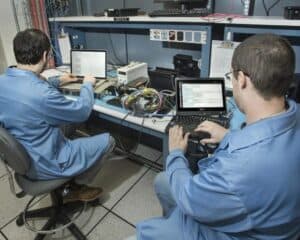Daq testing
“DAQ” typically stands for Data Acquisition, which refers to the process of sampling signals that measure real-world physical conditions and converting the resulting samples into digital numeric values that can be manipulated by a computer.
A “DAQ test” could refer to any test or experiment involving data acquisition systems. These tests could be in various fields such as engineering, physics, biology, or any other discipline where collecting data from sensors or instruments is necessary for analysis or monitoring.
What is DAQ testing?
Here are some key aspects of DAQ testing:
1. **Functionality Testing**: This involves verifying that the data acquisition hardware and software function as intended. It includes testing features such as signal sampling, analog-to-digital conversion, digital input/output, sensor interfacing, and communication protocols.
2. **Accuracy Testing**: It verifies the accuracy of the acquired data by comparing it to known reference values or simulated data. Accuracy testing ensures that the system provides reliable measurements within specified tolerances.
3. **Calibration Testing**: Calibration ensures that the data acquisition system produces accurate and consistent measurements over time. Calibration tests involve comparing the system’s output to a known standard and adjusting it if necessary to minimize errors.
4. **Performance Testing**: This involves evaluating the performance characteristics of the data acquisition system, such as sampling rate, resolution, dynamic range, noise level, and response time. Performance testing ensures that the system meets the required performance specifications and can handle the anticipated data acquisition tasks.
5. **Stress Testing**: Stress testing involves subjecting the data acquisition system to extreme conditions or high loads to assess its robustness and reliability. This includes testing under conditions such as temperature extremes, electrical noise, vibration, or rapid data acquisition rates.
6. **End-to-End Testing**: This involves testing the entire data acquisition system, including sensors, signal conditioning, data acquisition hardware, software interfaces, data processing, and storage. End-to-end testing verifies the system’s functionality, accuracy, and performance in real-world scenarios.
Overall, DAQ testing is essential for ensuring the reliability, accuracy, and performance of data acquisition systems across various applications, including scientific research, industrial monitoring, automotive testing, aerospace, and more.
Daq testing
How to test ni daq mac?
1. **Install NI-DAQmx Driver for macOS**: Visit the National Instruments website to download and install the NI-DAQmx driver compatible with your macOS version. The driver provides the necessary software interface for communicating with NI DAQ hardware.
2. **Connect NI DAQ Hardware**: Connect your NI DAQ hardware to your Mac using the appropriate interface (USB, Ethernet, etc.) and ensure that the hardware is properly recognized by your macOS system.
3. **Install NI LabVIEW or LabVIEW Runtime Engine (Optional)**: If you plan to use LabVIEW for DAQ programming and testing, you’ll need to install NI LabVIEW or LabVIEW Runtime Engine on your Mac.
4. **Use NI Measurement & Automation Explorer (NI MAX)**: NI MAX is a software tool provided by National Instruments for configuring and testing DAQ devices. You can use NI MAX to verify that your DAQ hardware is detected correctly, check device properties, perform self-tests, and troubleshoot any connection issues.
5. **Develop and Run Test Programs**: Use NI LabVIEW or another programming environment (such as Python with NI-DAQmx libraries) to develop test programs for your NI DAQ hardware. These programs can perform various tests, including functionality testing, signal acquisition, digital I/O testing, and more.
6. **Verify Data Acquisition**: Run your test programs and verify that the NI DAQ hardware acquires data accurately from connected sensors or input sources. You can use visualization tools provided by LabVIEW or custom data analysis software to inspect acquired data and ensure its correctness.
7. **Perform Calibration (if necessary)**: If your application requires calibrated measurements, you may need to perform calibration procedures using NI calibration tools and standards. Ensure that your DAQ hardware is calibrated periodically to maintain measurement accuracy.
8. **Test Under Various Conditions**: Test your NI DAQ hardware under different operating conditions, such as temperature variations, input signal ranges, and sampling rates, to ensure its robustness and reliability.
By following these steps, you can effectively test NI DAQ hardware on a Mac and ensure its proper functioning for your specific application needs.
Also Read..



